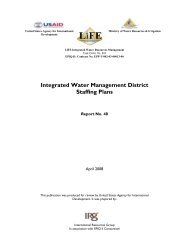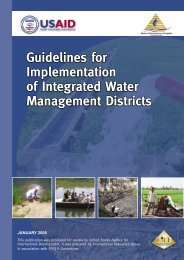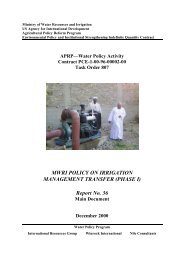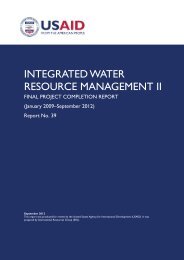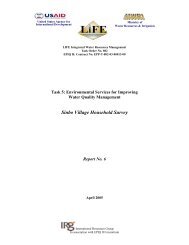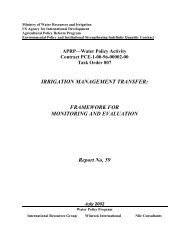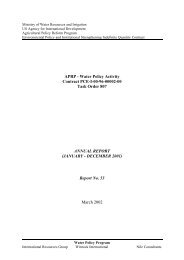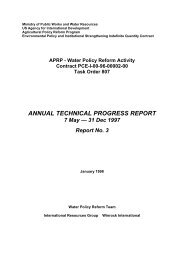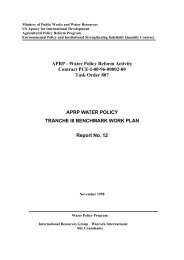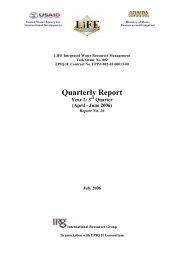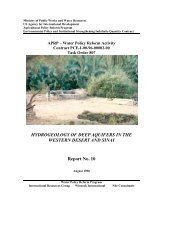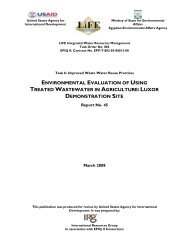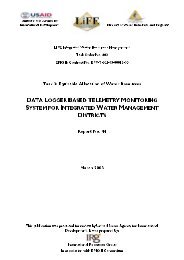INTEGRATED WATER RESOURCE MANAGEMENT II - LIFE-IWRMII ...
INTEGRATED WATER RESOURCE MANAGEMENT II - LIFE-IWRMII ...
INTEGRATED WATER RESOURCE MANAGEMENT II - LIFE-IWRMII ...
You also want an ePaper? Increase the reach of your titles
YUMPU automatically turns print PDFs into web optimized ePapers that Google loves.
The organizational indicators for IWMDs are<br />
• General management<br />
• Communication<br />
• Water distribution<br />
• Maintenance<br />
A farmers satisfaction survey and focus group meetings will be used to collect information to<br />
populate the BCWUA organizational indicators. A formal survey of BCWUA members is being<br />
conducted in the fourth quarter of 2011. At the same time, focus-group interviews are being held<br />
with the Boards of the sample BCWUAs to obtain their perspective on BCWUA capacity and<br />
performance. Follow-up focus-group interviews with the Boards of the sample BCWUAs will be<br />
conducted in the second quarter of 2012 to assess changes resulting from additional capacity building<br />
support provided by the project during the first half of 2012, if desired. The survey is being<br />
administered in a sample of BCWUAs in a sample of IWMDs in all eight Directorates covered by the<br />
project. In addition, it covers two Phase I Directorates which are contiguous with the East Delta<br />
Phase <strong>II</strong> project area, West Sharkia in the center of the East Delta and New Zifta just across the<br />
Damietta Branch of the Nile in the Middle Delta 2 . Including these two Phase I Directorates has the<br />
distinct advantage of projecting Phase <strong>II</strong> BCWUAs about 5 years into the future to see what their<br />
status is likely to be at that point. It will also allow an assessment of the strengths and weaknesses of<br />
the Phase I BCWUAs to see where additional training might be needed and where changes in the<br />
authority granted to them might be needed.<br />
Information to populate the IWMD capability indicators will come from three sources. First,<br />
extensive records are presently kept of various aspects of IWMD progress and performance for<br />
internal project management purposes. These records will be mined as a primary source of data for<br />
the capability indicators. In addition, project regional offices will conduct interviews with District<br />
managers to gather additional information. Finally, information for some of the performance-based<br />
indicators would be drawn from the client satisfaction surveys.<br />
PURPOSE<br />
The purpose of this annex is to report on Implementation Indicators though Year 3 of the project.<br />
Output Indicators require analysis of a variety of data collected from several sources which is<br />
underway. These indicators will be reported on in the final M&E report. Organizational Indicators<br />
will be assessed subjectively based on the results of the second farmer survey that is presently<br />
underway and the final focus group discussion that will take place in April 2012. These will also be<br />
reported on in the final M&E report.<br />
IMPLEMENTATION INDICATORS<br />
Implementation indicators are used to monitor the execution of project activities. They monitor the<br />
inputs supplied by the project to achieve desired change. Because they are related directly to project<br />
inputs, they can be keyed to the project tasks. Implementation indicators and their present status,<br />
organized by project task, are shown in Tables 2, and 3. However, Tasks 1.2, 1.4, 2.1 were<br />
terminated in mid-Year 3 and Task 1.4 was cut back. The tables show the progress achieved up to<br />
the point these tasks were terminated.<br />
2 Each of these two Phase I Directorates comprises 5 IWMDs.<br />
ANNUAL REPORT YEAR 3 (JANUARY – DECEMBER 2011) 33



